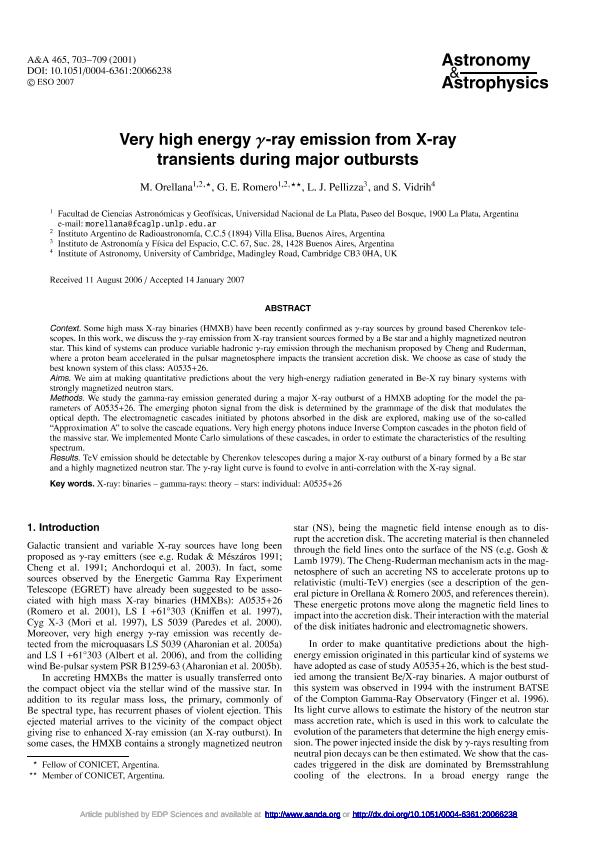Artículo
Very high-energy gamma-ray emission from X-ray transients during major outbursts
Orellana, Mariana Dominga ; Romero, Gustavo Esteban
; Romero, Gustavo Esteban ; Pellizza González, Leonardo Javier
; Pellizza González, Leonardo Javier ; Vidrih, S.
; Vidrih, S.
 ; Romero, Gustavo Esteban
; Romero, Gustavo Esteban ; Pellizza González, Leonardo Javier
; Pellizza González, Leonardo Javier ; Vidrih, S.
; Vidrih, S.
Fecha de publicación:
12/2007
Editorial:
EDP Sciences
Revista:
Astronomy and Astrophysics
ISSN:
0004-6361
Idioma:
Inglés
Tipo de recurso:
Artículo publicado
Clasificación temática:
Resumen
Some high mass X-ray binaries (HMXB) have been recently confirmed as γ-ray sources by ground based Cherenkov telescopes. In this work, we discuss the γ-ray emission from X-ray transient sources formed by a Be star and a highly magnetized neutron star. This kind of systems can produce variable hadronic γ-ray emission through the mechanism proposed by Cheng and Ruderman, where a proton beam accelerated in the pulsar magnetosphere impacts the transient accretion disk. We choose as case of study the best known system of this class: A0535+26.
Aims. We aim at making quantitative predictions about the very high-energy radiation generated in Be-X ray binary systems with strongly magnetized neutron stars. Methods. We study the gamma-ray emission generated during a major X-ray outburst of a HMXB adopting for the model the parameters of A0535+26. The emerging photon signal from the disk is determined by the grammage of the disk that modulates the optical depth. The electromagnetic cascades initiated by photons absorbed in the disk are explored, making use of the so-called “Approximation A” to solve the cascade equations. Very high energy photons induce Inverse Compton cascades in the photon field of the massive star. We implemented Monte Carlo simulations of these cascades, in order to estimate the characteristics of the resulting spectrum. Results. TeV emission should be detectable by Cherenkov telescopes during a major X-ray outburst of a binary formed by a Be star and a highly magnetized neutron star. The γ-ray light curve is found to evolve in anti-correlation with the X-ray signal.
Palabras clave:
Unavailable
Archivos asociados
Licencia
Identificadores
Colecciones
Articulos(IAFE)
Articulos de INST.DE ASTRONOMIA Y FISICA DEL ESPACIO(I)
Articulos de INST.DE ASTRONOMIA Y FISICA DEL ESPACIO(I)
Citación
Orellana, Mariana Dominga; Romero, Gustavo Esteban; Pellizza González, Leonardo Javier; Vidrih, S.; Very high-energy gamma-ray emission from X-ray transients during major outbursts; EDP Sciences; Astronomy and Astrophysics; 465; 3; 12-2007; 703-709
Compartir
Altmétricas



